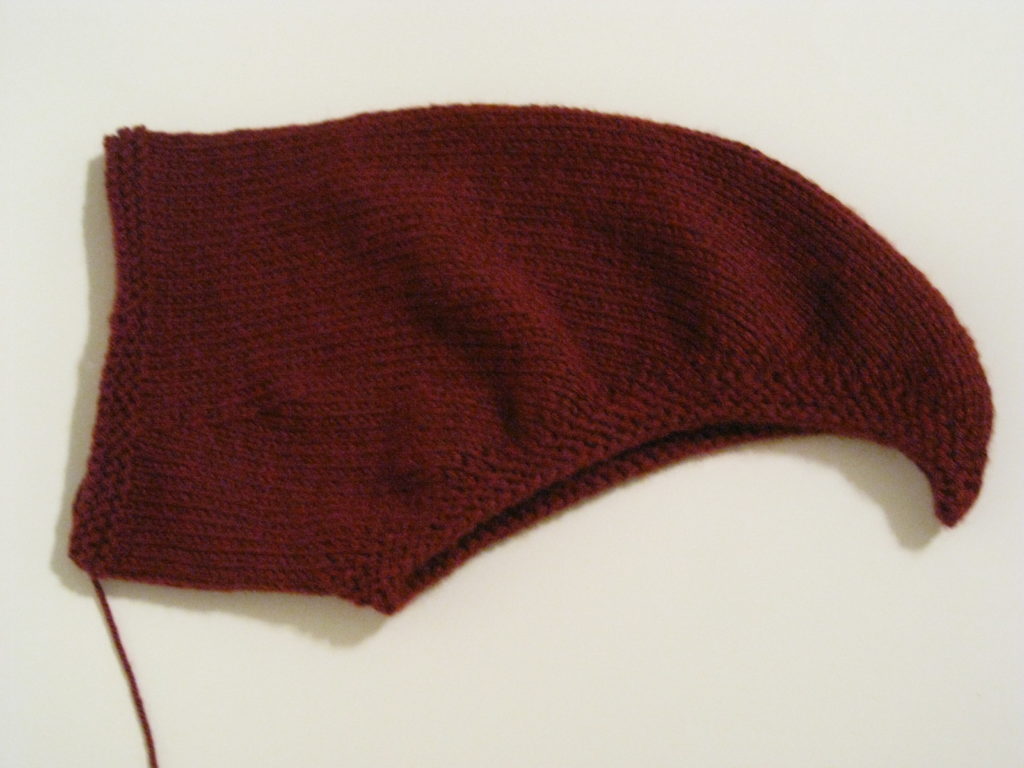Ah, the allure of the quick knit: cast on, click click click, and before you know it you’re binding off and jamming a new hat on your head or snuggling something warm about your neck. That was the goal with the Purl Bee’s Bandana Cowl, which I started last week during a bout of insomnia after finishing up another portable knit. It was late, but I wasn’t worried. I’ve knit cables, I’ve knit lace with thread-like yarn, I’ve knit with 1,000+ tiny, tiny beads—what’s a little bulky-weight yarn, US 10 needles, and stockinette in the round compared to that?
Apparently, a little more complicated than my smug self gave it credit for:
 I should have called this the Fowl Cowl. Doesn’t it look like an eagle’s beak?
I should have called this the Fowl Cowl. Doesn’t it look like an eagle’s beak?
As you’ve no doubt guessed, it’s definitely not intended to have a pronounced hook like that. About half way through I started to get suspicious that things were not going to plan, but I decided to trust the pattern and carry on. What I should not have trusted was my ability to read and follow simple instructions after my usual bedtime.
In order to get the bandanna shape, the pattern relies on short rows: rather than knitting the entire thing around and around like a hat, the front portion is knit back-and-forth, and each back-and-forth row connects to the next nearest stitch around the edge increasingly wider crescents. As a result, the front ends up longer than the back and creates the pleasing triangle shape.
For those of you interested in the technical bits, it goes a little something like this…
You start knitting, and then just past the point in the middle you stop, wrap the yarn around the next stitch without knitting it—we’ll call that wrapped stitch X
If you want the most dramatic short rows, the ones that will produce the biggest length difference between front and back, you wrap the next stitch after X, turn, purl to Y, wrap the next stitch after Y, turn, and continue in this fashion, working one more stitch in each direction on each pass.
This pattern, however, doesn’t require dramatic short rows, so instead of wrapping the very next stitch past X and the very next stitch past Y, you knit the first stitch past X and wrap the next one after that, and the same with the purl side. You turn the work half as often, gobble up the stitches twice as quickly, and produce a much shallower point, one that doesn’t curve in on itself. And that’s where I made my blunder: I missed the instructions to knit that extra stitch on each row, thereby giving myself double the work and creating the problems you see. Womp womp.
Another, less obvious problem I had is failing to follow the instructions for picking up wraps on the purl side as described i in the Purl Bee’s tutorial. Each wrap has two “arms” hugging the stitch its wrapped around, an arm on the public side of the work (the one people will see when it’s finished) and an arm on the private side of the work (the one against your skin). When picking up wraps, two things matter: making sure to lift the arm with the needle going front-to-back or back-to-front based on which side of the work you’re on (check!) and making sure to always lift the arm on the public side (whoops). I messed up picking up all of the private-side wraps. So on the public side, instead of being invisible, there is a little bar at the base of each stitch, like a purl bump. Lucky enough for me, the border of the cowl is garter stitch, so these bars blend in unless you’re looking very closely. Since they were basically unnoticeable, I was planning to leave them that way. But I’m going to be frogging and re-knitting the whole thing anyway, so this time I’ll make sure to pick up the wraps correctly too.
To be honest, I’m not even mad about the frogging. (Okay, I was a little mad, but only because I wanted a warm thing RIGHT NOW.) I was going to have some leftover yarn anyway, but now I think I can squeeze two small projects out of a single skein. And it should only take me four or five days to redo it, so it’s not like I’m going to run out of cold weather before I get to wear it. As far as failures go, I think this one is pretty manageable.
